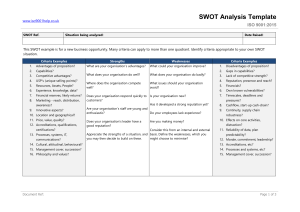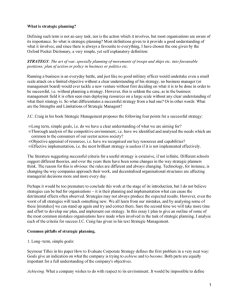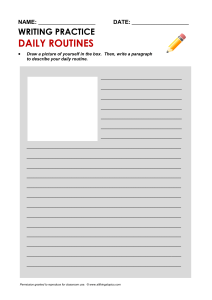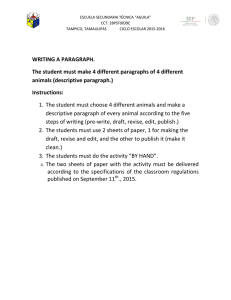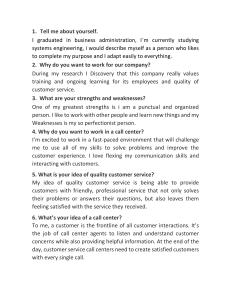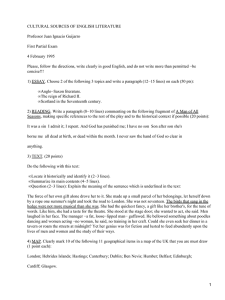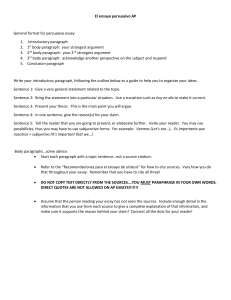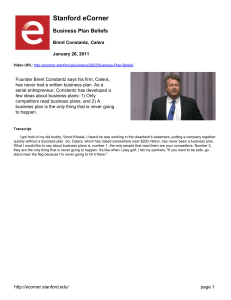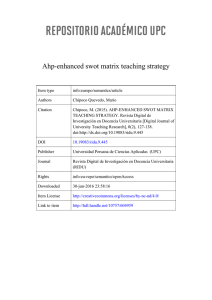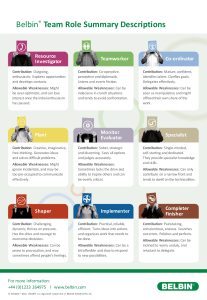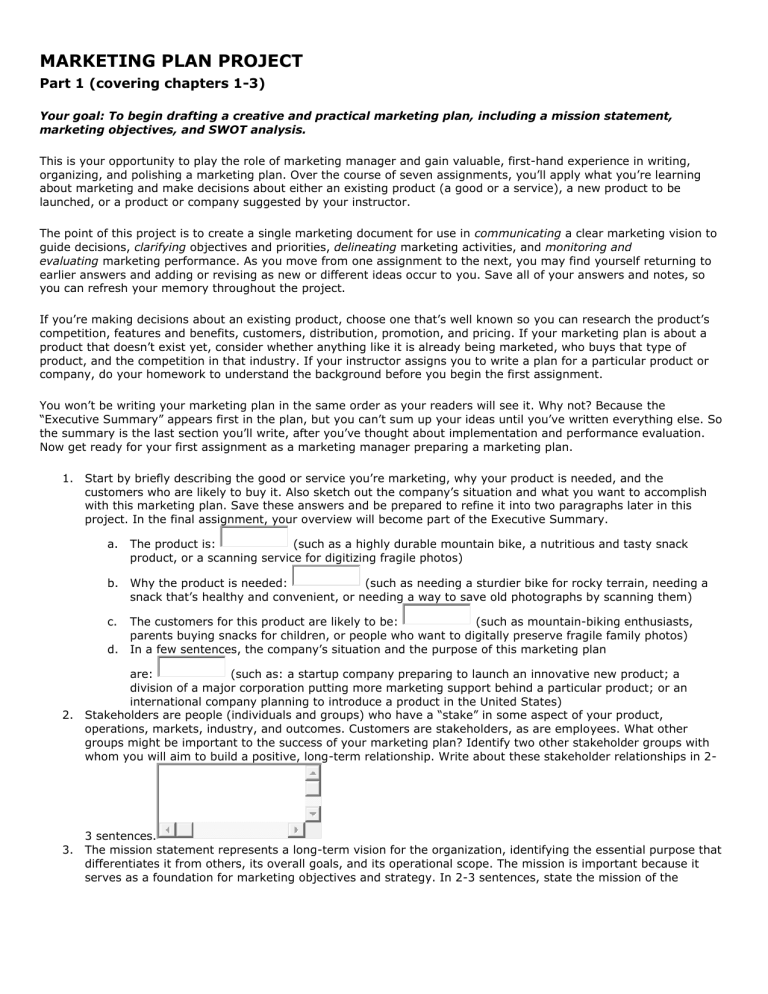
MARKETING PLAN PROJECT Part 1 (covering chapters 1-3) Your goal: To begin drafting a creative and practical marketing plan, including a mission statement, marketing objectives, and SWOT analysis. This is your opportunity to play the role of marketing manager and gain valuable, first-hand experience in writing, organizing, and polishing a marketing plan. Over the course of seven assignments, you’ll apply what you’re learning about marketing and make decisions about either an existing product (a good or a service), a new product to be launched, or a product or company suggested by your instructor. The point of this project is to create a single marketing document for use in communicating a clear marketing vision to guide decisions, clarifying objectives and priorities, delineating marketing activities, and monitoring and evaluating marketing performance. As you move from one assignment to the next, you may find yourself returning to earlier answers and adding or revising as new or different ideas occur to you. Save all of your answers and notes, so you can refresh your memory throughout the project. If you’re making decisions about an existing product, choose one that’s well known so you can research the product’s competition, features and benefits, customers, distribution, promotion, and pricing. If your marketing plan is about a product that doesn’t exist yet, consider whether anything like it is already being marketed, who buys that type of product, and the competition in that industry. If your instructor assigns you to write a plan for a particular product or company, do your homework to understand the background before you begin the first assignment. You won’t be writing your marketing plan in the same order as your readers will see it. Why not? Because the “Executive Summary” appears first in the plan, but you can’t sum up your ideas until you’ve written everything else. So the summary is the last section you’ll write, after you’ve thought about implementation and performance evaluation. Now get ready for your first assignment as a marketing manager preparing a marketing plan. 1. Start by briefly describing the good or service you’re marketing, why your product is needed, and the customers who are likely to buy it. Also sketch out the company’s situation and what you want to accomplish with this marketing plan. Save these answers and be prepared to refine it into two paragraphs later in this project. In the final assignment, your overview will become part of the Executive Summary. a. The product is: (such as a highly durable mountain bike, a nutritious and tasty snack product, or a scanning service for digitizing fragile photos) b. Why the product is needed: (such as needing a sturdier bike for rocky terrain, needing a snack that’s healthy and convenient, or needing a way to save old photographs by scanning them) c. The customers for this product are likely to be: (such as mountain-biking enthusiasts, parents buying snacks for children, or people who want to digitally preserve fragile family photos) In a few sentences, the company’s situation and the purpose of this marketing plan d. are: (such as: a startup company preparing to launch an innovative new product; a division of a major corporation putting more marketing support behind a particular product; or an international company planning to introduce a product in the United States) 2. Stakeholders are people (individuals and groups) who have a “stake” in some aspect of your product, operations, markets, industry, and outcomes. Customers are stakeholders, as are employees. What other groups might be important to the success of your marketing plan? Identify two other stakeholder groups with whom you will aim to build a positive, long-term relationship. Write about these stakeholder relationships in 2- 3 sentences. 3. The mission statement represents a long-term vision for the organization, identifying the essential purpose that differentiates it from others, its overall goals, and its operational scope. The mission is important because it serves as a foundation for marketing objectives and strategy. In 2-3 sentences, state the mission of the business behind the product being marketed, and explain what the mission means for customers and other stakeholders. 4. Now identify the marketing objectives, or goals, that will guide development of supporting marketing objectives and plans. State each objective clearly, making it measurable, and specifying a time frame. Be sure your objectives make sense in the context of the mission, the company’s situation, and its core competencies. Here’s an example: “Our company will sell 200 units per week during the first six months after product introduction.” Write at least 2 (and as many as 4) specific objectives you will seek to achieve by implementing this marketing plan. 5. Look again at the objectives you’ve just set. What standard(s) will you use to measure actual performance against expected performance? For example, if you set a goal of selling 200 units per week, your standard would be how many units the company really sells each week during the period covered by your marketing plan. Write a sentence or two describing your performance standard(s) for each objective. 6. Next, you will begin a SWOT analysis, assessing the company’s strengths, weaknesses, opportunities, and threats. Strengths are internal core competencies (such as having award-winning product designers on staff) that give it a competitive advantage. Weaknesses are limitations inside the company (such as lacking production capacity for higher output) that might create vulnerabilities and hamper its ability to achieve objectives. Opportunities are situations outside the company (such as unexpectedly high demand for a product the company can produce) that can be favorable for the product’s marketing. Threats are possible barriers outside the company (such as new competitors) that might prevent it from achieving its goals. Start with strengths, inside the company. In a four-cell matrix like the example, list 2-3 bullet points about the company’s core competencies, what it can do better than any other competitor, and any unique resources that it can access to leverage external opportunities. Strengths: 7. Continue with your SWOT by considering which limitations inside the company you consider to be its weaknesses. List 2-3 bullet points about these weaknesses, explaining why each might be a problem. Weaknesses: Separately, write 1-2 sentences explaining how you can improve and try to convert these weaknesses into strengths. 8. For your SWOT analysis, look at opportunities outside the company that you may be able to exploit by matching them with strengths. Consider what these opportunities mean for competitors, as well. List 2-3 bullet points about these opportunities and how they fit with your firm’s strengths. Threats: 9. The final element in your SWOT analysis is assessing threats outside the company that you can try to convert into opportunities. In what ways could these threats change the market or the competitive landscape? List 2-3 bullet points about these threats and write 1-2 sentences about possible approaches to minimizing threats or converting them into opportunities. Opportunities: 10. Optional, as your instructor directs: In a team or individually, identify a highly successful, real-world competitor to the product in your plan. Why is this competing product so successful, and what are its vulnerabilities? What features and benefits does it emphasize, and how do these fit with customers’ needs and preferences? What can you learn from this product’s success and any serious challenges it faces now or may face in the near future? Write a paragraph or prepare a brief (five-minute) presentation about this competing product and how you can use your marketing plan to compete effectively against it. Your goal: To analyze the marketing environment and plan for ethics and social responsibility. In this portion of the assignment, you’ll take a closer look at the marketing environment in which your company operates. Six specific areas to examine are: competitors, the economy, political forces, legal and regulatory forces, technology, and sociocultural forces, all of which affect the marketing plan you’re developing. You’ll also consider the role of social responsibility and ethics in your marketing plan. 11. Your first step in analyzing the marketing environment is to examine the competition. What brands and products compete with yours? How strong are these competitors, and what weaknesses do you see? Does your industry have only one competitor (a monopoly) because there are no close product substitutes or because of barriers to market entry? Does your industry have a few competitors with some barriers to entry (an oligopoly)? Or does your industry have many competitors and a lot of product differentiation (monopolistic competition)? How much of a role does competitive pricing play in your market(s)? Identify two specific competitors, and look at their strengths and weaknesses. What are the implications for your competitive strategy? Write two paragraphs about competition and the specific rivals you plan to monitor. Competitive Environment 12. Find out how local, state, or federal laws and regulations might affect your ability to achieve your marketing objectives. Search the Internet to find at least two federal laws that apply to your product (such as the Nutritional Labeling and Education Act, if you’re marketing a food product). Look for a state or local law or regulation that applies to your product, such as needing a license to provide a certain type of service. Finally, conduct a search to see whether any new laws and regulations—or major legal and regulatory changes—are in the works. Write a paragraph about the legal and regulatory climate for your product, including the possible effect on your marketing plan. Legal Environment 13. Political forces are another key aspect of the environment to analyze. Pay close attention to the current political situation in the geographic area(s) where your product will be created and marketed. Think about the ways in which politics might affect the design and production of your good or service, the way you promote the product, how the product is transported and distributed, and your pricing decisions. For example, consumer groups and political action committees may try to influence the outcome of proposed legislation or change existing laws. Identify at least two elements of the political situation that you must understand to successfully put your marketing plan into action. Write a paragraph about these political factors and the overall political situation in the areas where your plan will be implemented. Political Environment 14. Next, research the economic conditions in the market where you will sell and the market where you will buy supplies or services. Identify the point in the business cycle where these economies appear to be. Do economic conditions constitute an opportunity or a threat? Then determine how much buying power customers are likely to have once they have access to your product—and how willing they will be to make purchases. What changes in the local, national, or international economic situation could affect your marketing performance, and in what ways? Write one or two paragraphs about the current economic situation, not just in your specific business location(s) but also in the broader economic context. Economic Environment 15. Within the technological environment, what are the key trends that could be positive or negative for your product? What new technologies are emerging that could influence your ability to implement your marketing plan? Are any new technologies expected to make competitive products obsolete or make it easier for customers to buy and use your product? Write a paragraph about how technology can help you to pursue opportunities or fend off threats, develop products, connect with stakeholders, compete more effectively, or otherwise affect your marketing plan. Technological Environment 16. Sociocultural forces are one final set of forces you’ll need to analyze within the marketing environment. How will demographic and diversity characteristics such as age, gender, ethnicity, income, and family composition affect your customers, their needs, and their buying patterns? What about the effect of cultural values on your marketing plan (such as the importance of nutrition and exercise or increased interest in earth-friendly products)? What changes occurring now (or projected for the near future) should you consider as you plan? Write a paragraph about the key sociocultural forces that affect your customers, your market(s), and your product. Social-Cultural Environment 17. Now it’s time to focus on ethics and social responsibility. What ethical issues have emerged in your industry or have been linked to products like yours (such as questionable pricing practices)? Are there any potential conflicts of interest you must avoid? What social responsibility issues are important for your product and your stakeholders (such as working with suppliers that don’t hire children or using earth-friendly materials)? What are competitors doing about these issues? How can you address these issues in your marketing plan? Write one or two paragraphs about how you plan to deal with ethics and social responsibility. 18. Optional, as your instructor directs: In a team or individually, explore what two of your product’s competitors are doing to demonstrate social responsibility. For example, are they promoting “green” products or supporting efforts to reduce poverty? How do these competitors communicate about their social responsibility actions? Based on what you find out, which of these two competitors appears to have the most powerful stakeholder appeal on the basis of social responsibility? What lesson(s) can you learn from these competitors to strengthen your marketing plan? Draft a paragraph or plan a brief (three-minute) presentation explaining your ideas, with specific examples from the competitors you studied. 19. BUILDING YOUR MARKETING PLAN: For now, leave your answers to Question #1 aside, to be reviewed, revised, and summarized in your “Executive Summary,” later in this project. Transfer your answers to Questions #2 and #3 to a Marketing Plan document, arranging them under the “Executive Summary, Competitive Analysis, and Mission Statement” section. Transfer your answers to Question #4 to the “Statement of Goals and Core Competencies” section. Transfer your answers to Question #5 to the “Budget, Schedule, and Monitoring” section. Transfer your answers to Questions # 6, 7, 8, 9, 11, 12, 13, 14, 15, 16, and 17 to the “Situation Analysis” section. If you’ve identified any particularly challenging or particularly favorable environmental factors, note the highlights in your “Executive Summary.” Save all of your work, because you will be adding to these sections throughout this project.
